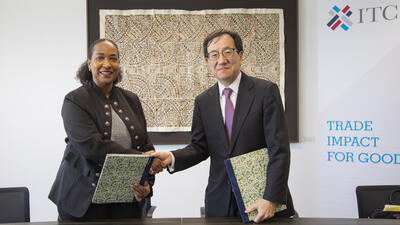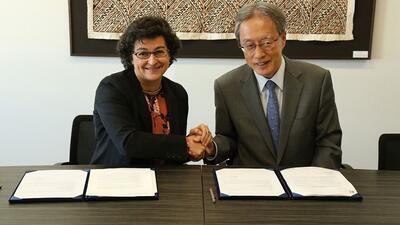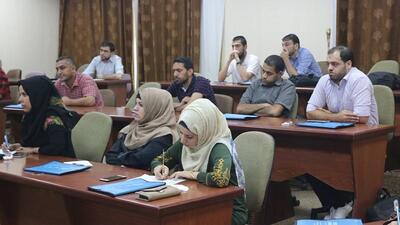Remarks at the IDE-JETRO Seminar (en)
11 December 2014, Tokyo, Japan
(CHECK AGAINST DELIVERY)
It is a great pleasure for me to be here today to talk about ITC’s work in the area of Small and Medium-sized Enterprises, Global Markets and Sustainable Growth.
ITC’s role is to support developing countries – and notably SMEs in those countries - to connect to regional and global markets. We used to call this exports. We have moved to trade. We now prefer 'internationalization' which brings together trade, investment and innovation.
Promoting trade and investment is an area you are only too familiar with: it is the bread and butter of JETRO’s work. I therefore look forward to sharing my views with you, and even more to receiving your feedback.
A changing global environment
Global markets have gone through a tough period in recent years. There has been a lot of instability, notably in the financial markets. Given the importance of finance, and in particular of trade finance, in making the trade engine work, this instability has been harmful for trade.
The 2008 crisis also led to the adoption of trade and investment protectionist measures which although not widespread, have accumulated and added to the costs of global trade.
We also now know that trade growth is being affected by the slowdown in value chain expansion in East Asia, in particular from China's in-sourcing of many of its previously imported components.
Other events that have affected global trade are unrelated to markets, but were instead due to nature. I am thinking of the tsunami that hit your country in 2011. The 2011 tsunami not only hit the Japanese coast, it hit the world economy, because of Japan’s high level of integration in global markets. The tsunami also hit the spirits of supply chain managers in global companies, as the risk of the ‘missing link in the chain’ suddenly became very tangible.
The turbulence of recent years has had at least two effects on global trade:
(i) at the policy level, it has weakened support for open market policies in some quarters
(ii) in the private sector, it has led some global suppliers to rethink their business models.
Regarding the first effect, the global financial crisis has made policy makers very aware of the fact that openness exposes countries to shocks coming from elsewhere. The term openness, long associated with dynamism and resilience, suddenly became synonymous with terms like ‘risk’ and ‘vulnerability’.
Policy support and indeed public support for open market policies suffered, and those advocating open markets found themselves in an increasingly uphill struggle. This has certainly been felt in Geneva, where the WTO has found it hard to make progress on the Doha Round. Even if the recent conclusion of the WTO trade facilitation agreement which had been adopted in Bali last December is cause for hope.
The crisis of confidence in the open global economy has even caused some to go so far as to argue that the time of ‘export led growth’ is over, or that developing countries do not need to care about trade and FDI when designing policies for sustainable growth.
Downplaying the role of openness for growth is a mistake, and that advocating closed borders to developing countries is equivalent to asking them to close their doors to information, finance, innovation and - more generally - to progress.
The second effect the shocks of the 2007 to 2011 period have had is that global suppliers have started to rethink their business models. Before the crisis, we were living in a world where the number of pieces a supply chain could be split into seemed to become larger and larger. Yet splitting up your supply chain implies increased co-ordination costs and more risks to manage risks. Increased awareness of risks in global markets has made the idea of tightening the links in the supply chain more attractive, and we are observing a certain trend towards shorter supply chains and more regional (rather than global) supply chains.
This phenomenon of a changing business model is reflecting rational business thinking in the context of the current external environment. It is something that policy makers have to take into account when thinking about how to connect their businesses to global markets. The opportunities for growth through openness continue to exist, but it may have become harder to capture them.
Openness continues to be good for growth but it may have become harder to connect to global markets.
I believe that openness is good for growth. I am convinced by the academic evidence showing that economies tend to experience on average one to two per cent higher growth rates after opening trade. Of course China with its impressive growth rates in both GDP and exporters is one of the drivers of that average figure. But these figures also reflect the strong performances of countries like Botswana, Chile, Costa Rica, Ghana and Poland. All these countries are very active players in global markets, and all experienced average annual growth rates of above 4% over the past 20 years -- well above the global average.
At ITC, we support developing countries that are not yet well integrated in regional and global markets to strengthen their capacity to do so. More generally, we are gearing up our work to help policymakers, trade support institutions and SMEs become smarter and more effective in connecting to these markets. The opportunities continue to exist, but they may be harder to get in the near future. Our mission is to help policymakers and business to capture those opportunities and transformthem into sustainable development and growth.
While doing this, we are very aware of the fact that becoming competitive and remainingcompetitive is extremely tough in today’s fast moving and rapidly changing world. It is not only important for businesses and economies to be competitive today; they also have to be able to adjust to changing conditions in order to continue to be competitive tomorrow.
ITC helps business to connect to global markets: we intervene at four levels
I use the terms ‘SMEs’ and ‘economies’ in the same sentence on purpose. Much of ITC’s work focuses on businesses. They are the entities that conduct trade and that compete in global markets. But the business environment they operate in is an important determinant of their competitiveness. The rest of the economy – for instance the functioning of labour and product markets – and institutions mattera great deal. They matter at the macro level, but they also matter at the regional or sub-regional levelswhere individual firms operate.
Within partner countries, ITC therefore works at different levels: we work directly with SMEs, we work with trade and investment institutions in their direct environment as well as at the national level. Last but not least, ITC is also active at the global level, as a provider of global public goods.
Let me give you some examples for these different layers of activities:
(i) As a global information provider, we focus on providing market intelligence of direct relevance to exporting and importing business. Through a number of e-platforms, we provide information about tariff and non-tariff measures in target markets. When it comes to non-tariff measures, our work not only covers governmental regulatory measures, but also private standards, notably in the area of sustainability standards that can represent obstacles but also great opportunities for SMEs in developing countries. Increasingly, we are moving into the direction of providing exporters with information about their potential for exports in the future, or in unexploited markets.
(ii) Our market analysis tools also allow us to provide information that is of particular relevance to national governmental and non-governmental actors. ITC, for instance, conducts firm level surveys on non-tariff measures. Those surveys allow national policy makers to identify procedural obstacles within their countries that may negatively affect the competitiveness of their exporters.
(iii) At the national level, we work closely with trade promotion organizations. ITC’s biannual World TPO conference is the only event of this nature that brings TPOs from all continents together to exchange views and learn about best practices. The best trade promotion practices yield outsized trade benefits for each dollar spent. In our technical assistance toTPOs, we assist them in strengthening their own service delivery to clients, notably by helping them to strengthen their information and intelligence systems.
(iiii) We offer similar services to regional or sectoraltrade support institutions in projects that do not have an economy-wide reach. We work with sectoral producer organizations or with local or regional certification bodies when our projects aim at raising the competitiveness of a particular sector.
(v) Last but not at all least, we work directly with enterprises. Here, our focus is mainly on small and medium sized enterprises.
SMEs play a crucial role in transforming the opportunities of global markets into sustainable growth
I mention this SME focus last not because it comes last in our list of priorities, but because this gives me the opportunity to dedicate the last part of this dialogue to SMEs. I wish to do so because ITC is increasingly building its intervention logic around the concept of the international competitiveness of SMEs.
SMEs have an important role to play in order for economies to transform the opportunities of global markets into sustainable growth. Here I would like to treat the terms ‘growth’ and ‘sustainability’ separately.
SMEs play a role in transforming opportunities into growth and development, because strong and dynamic SMEs are a core ingredient of a dynamic and agile economy. Too many poorer economies are characterized by a private sector split into two segments: a huge number of small, often micro- and informal enterprises on the one hand; and a handfulof very large enterprises on the other hand. This situation, often described as a ‘missing middle’, can easily lead to stagnation in the private sector, as the few large players do what they can to maintain the status quo and take advantage of their market power. Small players, meanwhile, are too small to challenge the big players and to lobby for policy change.
Economies with a healthy and dynamic ‘middle’,instead, tend to be more dynamic as a whole. The United States is sometimes taken as an example for this. Both the entry and exit rate of new business is around ten per cent in the United States, which is a high figure compared to other economies. But these figures have also often been associated with the dynamism of the US economy, a dynamism that may have contributed to the country’s capacity to recover from the recent global financial and economic crisis.
SMEs do not only play an important role in driving growth they also play an important role (and arguably an even more important one) in making growth from trade sustainable. Those of us active in international trade know by experience that large players find it easier to take advantage of global market opportunities.
Economic theory and empirical work have confirmed this: in general it is the case that big players become bigger when markets are open, while small players find it harder to survive. While this is desirable from the point of view of average productivity in a static environment, this situation bears two risks:
• One is that global economies become less and less dynamic if dominated by a few, large global players. This goes back to the argument I made before.
• The other is that the distribution of gains from trade becomes more and more unequal, with a few actors capturing most of the gains. Indeed, the theme of inequality has been high on policy makers’ agendas in recent years. The runaway popular success of Thomas Piketty’s work on inequality explains why: inequality has become a top concern of voters in many countries, be they low, middle or high-income.
A strong SME sector can contribute to a better distribution of the gains from trade for three reasons:
1. SMEs represent the smaller and more vulnerable part of an economic structure. If SMEs manage to connect to global players or manage to directly import and export, a larger share of the gains from trade is distributed from large to small players.
2. SMEs generally employ 60 per cent plus of the private sector work force. Benefits accruing to SMEs are therefore benefits accruing to the majority of the work force.
3. SMEs tend to be major employers of more vulnerable groups in the economy, in particular the young and women. More and better jobs in SMEs therefore tend to disproportionately help youth and female workers. And we know that women invest around 90% of their revenues in their families and communities compared to 40% in the case of men. Fostering women's entrepreneurship is therefore a great tool for more inclusive growth.
Strengthening the role of SMEs in global markets can also have important benefits for Asian economies
These three reasons for why a strong, globally connected SME sector is desirable are also true for the Asian region. SMEs represent well beyond 90% of all enterprises in Asian economies. They represent the main employers in the region, and in some major economies – like China, Indonesia and the Republic of Korea – their share of employment is above 60 per cent. Moreover, SMEs are a major employer of female and young workers. Indeed, 35% of all SMEs within the Asia-Pacific region are women-led.
As in the rest of the world, Asian SMEs are vulnerable. In some countries, the productivity gap between small and large companies is huge. In India, for instance, enterprises with more than 200 employees are 10 times more productive that enterprises with 5 to 49 employees. SME productivity also differs widely across Asian countries, with labour productivity in Indonesia being double that in India, and labour productivity in Thailand being more than double that in Indonesia. The potential for improvement is huge. It is well-known that enterprises that export or import are more productive than enterprises that are disconnected from global markets.
Currently, only around 35% of SMEs in the Asia-Pacific region are exporters. Assisting SMEs in raising their competitiveness and in connecting to global markets can therefore be hugely beneficial.
ITC helps SMEs to raise their competitiveness by helping them to:
(i) Be better at what they currently do;
(ii) Be informed about what opportunities are in regional and global markets;
(iii) Be ready to adjust to changes in regional and global markets.
In order to achieve this, we work with the different institutional players including with trade support institutions like JETRO. We assist policy makers and trade institutions in strengthening national information systems related to trade and investment. We also help policy makers to create a business environment that is supportive of change as we believe that this is important for the competitiveness of SMEs.
Let me close this intervention with a reference to the words of Dr Alan Bollard, APEC Secretariat Executive Director: ‘We are in a changed environment marked by lower trade and economic growth which is ramping up focus on new engines for growth. Increasing the trade share and productivity of SMEs are central to the new growth equation given that they’re everywhere and everything in our economies.” In the area of trade, the world is definitely increasingly looking at the Asia-Pacific region, which has been one of the major drivers of global growth in recent years. Combine the importance of the Asia-Pacific region for trade, with the region’s focus on SME policies, and you will understand why I am particularly pleased to be heretoday, and why I look forward to future collaboration with JETRO, IDE and other institutions in the region.
Thank you for this opportunity and I welcome dialoguing with you further.








